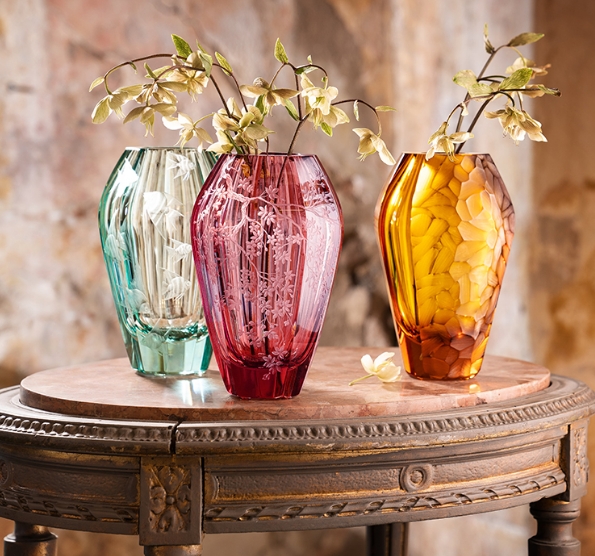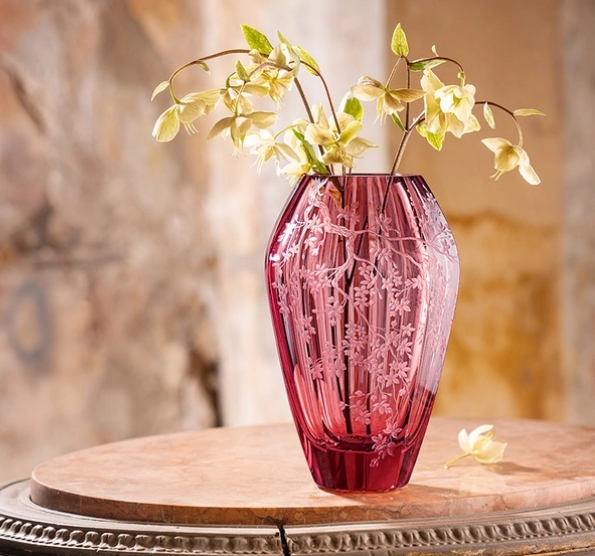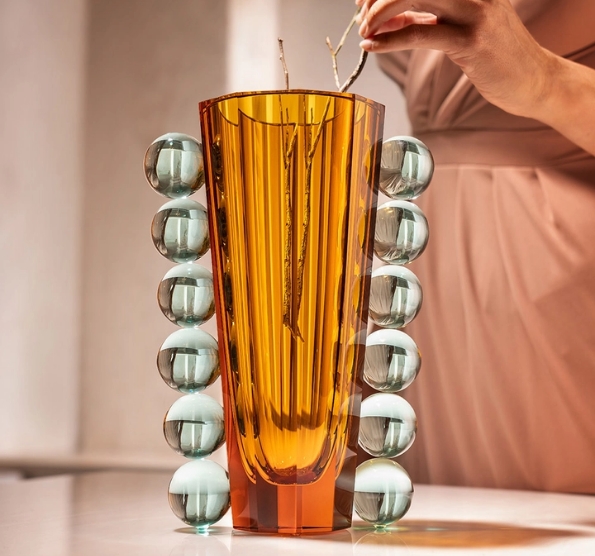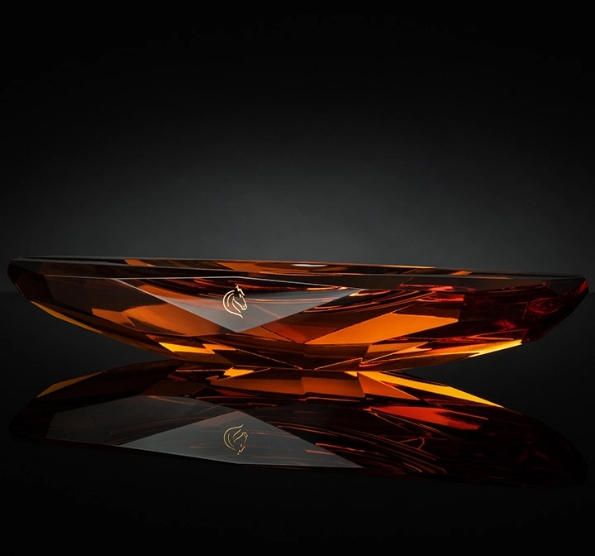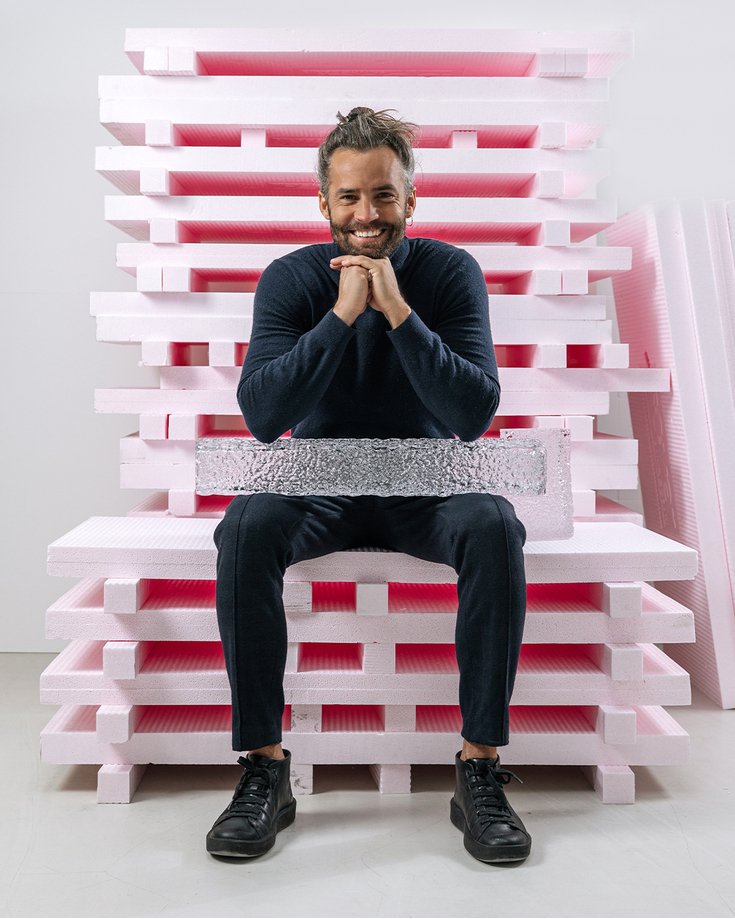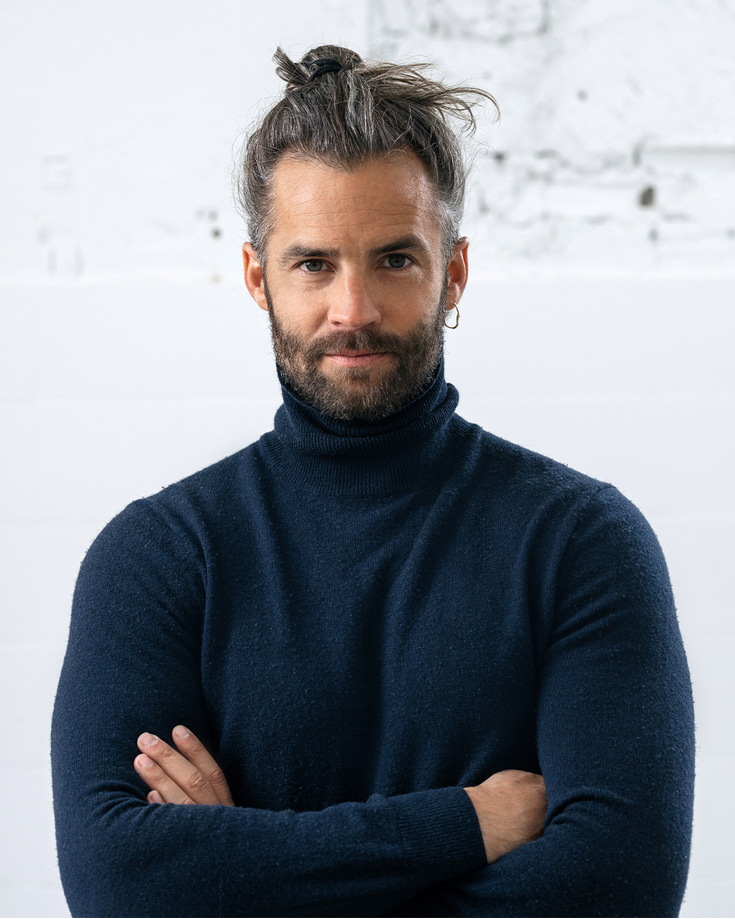Breadcrumbs navigation
- Home page
- About Moser
- Blog
- What is my biggest task? To awaken desire, says the new art director of Moser
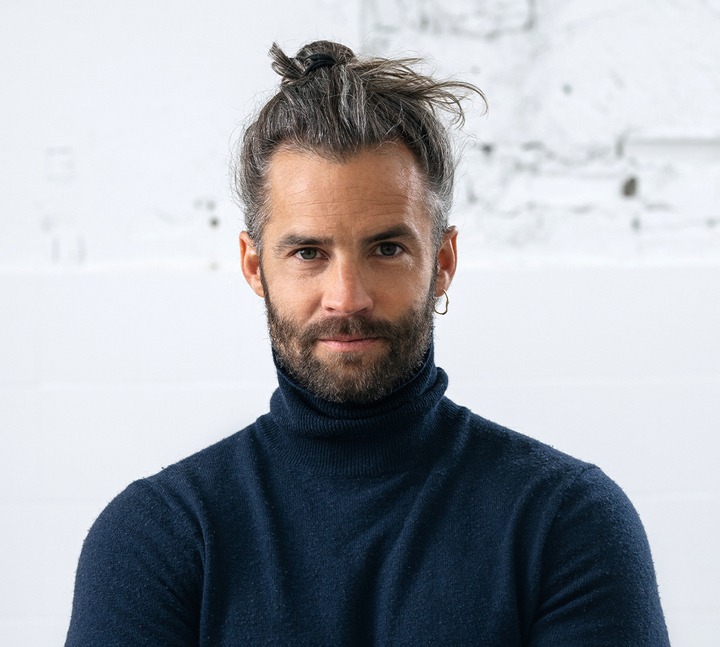
What is my biggest task? To awaken desire, says the new art director of Moser
“We don't have a doorbell, so call me when you’re here!” Jan Plecháč texts us on the day of our meeting in his studio in Vršovice. While the studio of Moser’s new art director is a bit incognito, his work can be seen all over the world.
He has completed projects for the Danish brand Menu, he collaborates with the Italian furniture manufacturer Cappellini and other top companies in the field of design. Until 2019, he had worked with his former classmate Henry Wielgus, whom he met at the Academy of Arts, Architecture and Design in Prague. Together they designed, for instance, lighting fixtures for the Czech brand Lasvit, which decorates interiors across the globe. Now, another great challenge awaits him: to start a new era of the legendary Czech glassworks.
It’s the first spring-like day and we are standing in front of the apartment building in Vršovice. We dial Jan’s number, according to his instructions. “I’ll be right there!” He announces, and in a few seconds, he opens the heavy front door. A dark corridor leads us to the courtyard, where a new world begins. Sunny, full of light. A pharmaceutical factory used to be here, but Jan reworked the place and gave it a breath of fresh air. He whitewashed the exposed bricks and replaced part of the partitions by glass windows with wooden framing.
It used to be a place where ointments and pills were made, but now, top design works are created here. Next to a wall, there is also an old Jawa that the passionate biker Jan and a group of craftsmen and artists redesigned beyond recognition during Designblok 2020. A jeweller engraved the engine cover, an airbrush artist and an illustrator covered the tank in bright colours, bagmakers added a leather saddle…
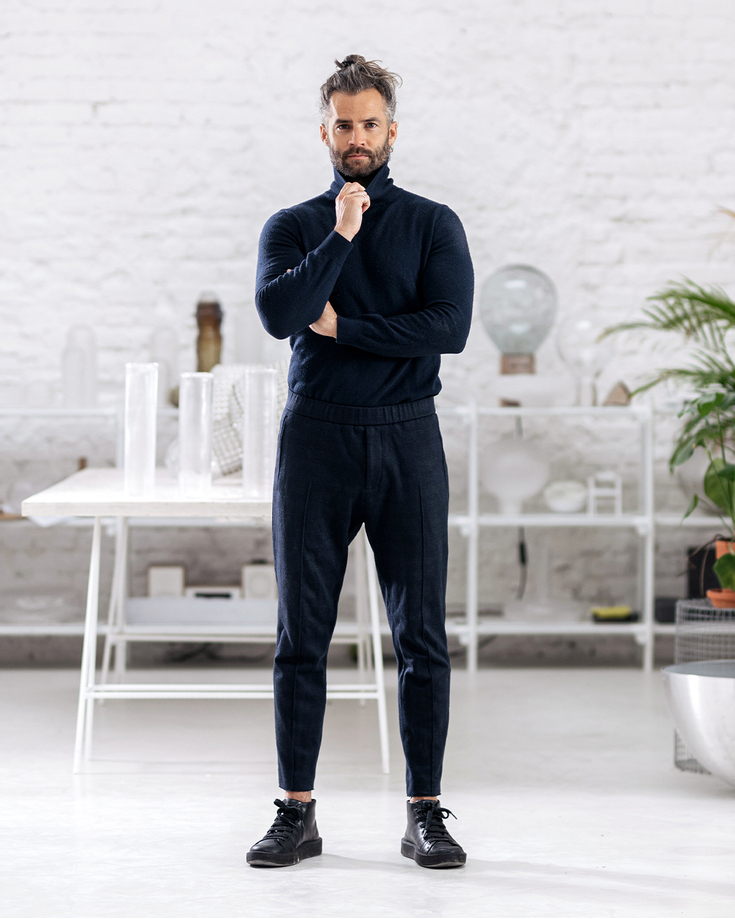
You once said that during the reconstruction of the motorcycle, the masters of their craft stepped out of their comfort zone. As the art director of Moser, will you strive for the same in the case of glassmakers and other professions?
Definitely. I would like to motivate people to try the things that they are not completely used to, to step out of the routine, and to push the boundaries of glassmaking. After all, I can hardly work in any other way. I leave my comfort zone almost constantly. I experiment and push the boundaries of what is possible. I’m a bit of a stuntman – my journey is often risky and bone-shaking, but when everything turns out good in the finish, it’s an unbelievable satisfaction. I don’t think that I could even enjoy taking the simple and comfortable road.
When you push your boundaries while creating, is the quality of the resulting work higher?
Yes, I personally believe that it is. Henry and I often said that unlike other studios, we do not have a clearly identifiable image, but we are defined by the process itself. We have never been shapers, rather, we were inventors. Behind each of our projects, there is a certain thoughtfulness or intellectual concept. Look at this, for example (Jan points his finger behind himself where the snow-white modular shelving system stands) – you can disassemble the whole thing, move it, and give it a completely new shape at another place. I’ve always seen the essence in how things are created rather than in what they look like.
Maxim Velčovský, the creative director of Lasvit and a friend of yours, also visited you today. What did he tell you when he heard that you were going to work in Moser?
He wished me sincere condolences (Jan laughs). But he immediately added that if I could make the glassworks more dynamic, it would be great. And he also said that I’m about to be faced with some hard work.
Why exactly?
Of all the Czech glassworks, Moser is the most difficult to lead creatively. Younger glassworks do not carry such a huge burden of tradition, so I would have had it easier with them. But once we dust the Moser brand off, great projects can be made here. Working for Moser should be an honour – not because of its rich history, but mainly because Moser is the birthplace of incredible accomplishments. I want the brand to be authentic, confident, and to resonate with society. A brand that goes beyond decorative glass and tries the things that no one else dares to do.
Online calendar? Nothing for Jan Plecháč. He writes his plans on papers and then sticks them to one of the studio walls. Meetings and also important strategies are written down here. “When Moser’s marketing director Martina Jirásková asked me when we could meet, I said that I don’t know – and that I have to look at the wall first,” he laughs. “But that's how I work the best, I hardly ever use a computer. I sometimes look at that wall for maybe four hours before adding a new piece of paper, but when I finally do, it’s always worth it.”
Your plans for changing the Moser brand are also on this wall. What do you see as your main task?
I must add that before Maxim came here, I hid many of the papers into the closet so he wouldn’t see too much of my thoughts! (Jan laughs). During the job interview, when the shareholders asked me how I would like to raise the value of the brand in my ten years as an art director, their question was followed by the longest silence in the history of meetings. And then, the answer finally arrived. I said that I wanted Moser to have a soul. And I think they liked my response. I didn’t want to talk about numbers, it’s much more important for Moser to be respected and authentic, which are some of the values you cannot buy. I would like to reduce the portfolio and get rid of the things that should not be associated with the brand because they may devalue other products. I would also like to get a greater diversity of emotions into the products. For example, by trying to make not only polished objects, but also matt, robust, or fragile pieces. I want to create works that you will crave. To awaken desire, that is my biggest task. Just like when the new Porsche 911 gets released and people, myself included, say: Absolute beauty, that’s what I want! I believe Moser has the potential to arouse longing. However, the change does not only concern the product, but also the overall attitude of the brand. We now need to put our heads together and figure out how to make the change.
Have you already come across any Moser products that evoke the desired emotion?
I was especially amazed by the older collections that I saw in a museum. I would like to follow up on the beautiful old sets that were created by Moser about a hundred years ago. I was fascinated by the colours and the diversity of the time, larger objects were made with thin glass. These were slowly forgotten. I now have a unique opportunity to offer a new perspective and to revive the designs. To redefine what belongs to Moser and what doesn’t. I also want to initiate new collaborations with designers from the Czech Republic and abroad, to prepare a functional field into which they can place their projects, and to gradually add my own as well.
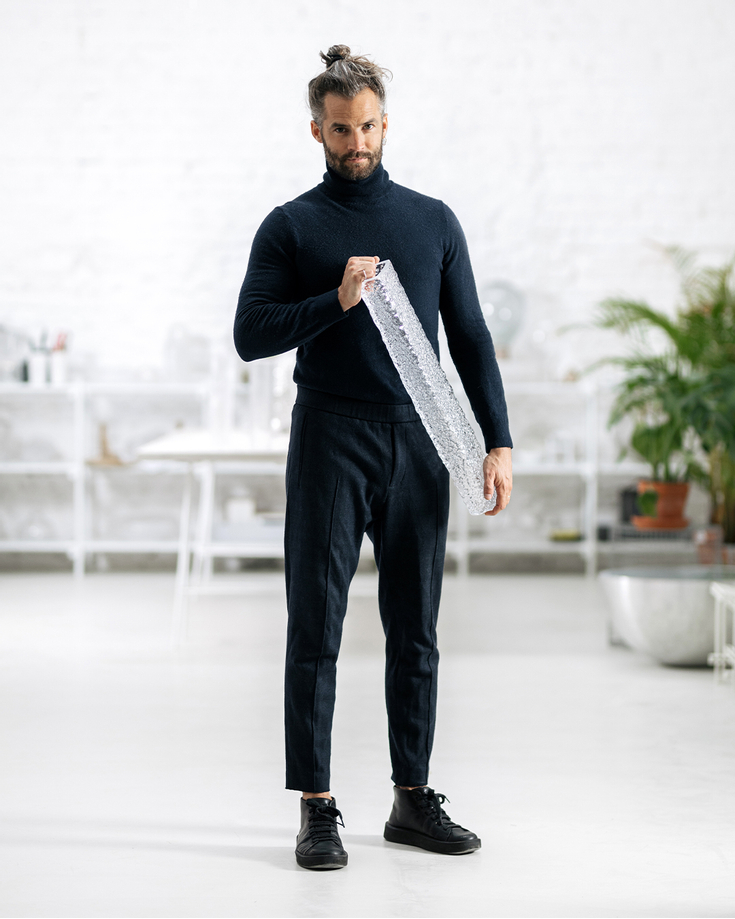
Will you be browsing the archives when searching for the historical collections?
For sure! I will wallow in them! And I’m really looking forward to it. But I was told that the archives are in the attic of the glassworks, and I haven’t gotten there yet. But when I say wallow, you should imagine mental wallowing rather that the physical one. These are some very old originals that should not be touched much.
During the interview, Jan Plecháč demonstrates the diversity of emotions that can be evoked by glass objects. Suddenly, he heads to the back of the studio to bring the shades from the Polygons collection, which he designed with Henry Wielgus for Lasvit. They are unique in their sharp geometric shapes and various types of grinding. While one shade is clear, smaller, and provided with gentle plating in holographic shades, the other is much larger, anthracite, and finished with a matte cut. "The first object has a more subtle, feminine energy, while the second one is heavy and robust. Completely different emotions,” the designer explains.
Brutally precise work
What crossed your mind when you first entered the glassworks as a future art director?
It was a completely new feeling. Until then, I had only visited the glassworks as an external designer. Now, for the first time, I’m part of the whole thing. Also, Moser is not just a smelter, it’s a whole factory. Before Christmas, I was there for the first time, and I wasn’t even officially on board yet. The lady at the reception was looking at me, unsure of what to think of me, she checked the contents of my backpack like she does with all the other visitors, and when I was leaving, she said, “Oh, you're probably going to do some work here!” And I said: “Yeah, I’m going to do some work here.”
Some masters have been working in Moser for fifty years. How will you find your way to them?
I know that it is very important to establish good relations, this sector is all about people. That’s why I told the management before joining that at the beginning, I would like to listen as much as possible and talk as little as possible. To meet the local masters, observe them, look at what they do and get to know their craft. The workers in the glassworks are often old hands. Initially, they look at one another and say: “Oh no, a designer, and with a braid!” But then, we get to know each other, and we like each other. I’ve already made friends among some of the Moser masters. We chat, they tell me what they like, and I listen.
What fascinates you about the individual professions?
Look at, for example, grinding and engraving. To me, that is a newly discovered world of refining things. I keep admiring the skills of these people, their concentration. One wrong move can damage the entire work! And glass cutters are incredibly hard workers, their hands are submerged in water all day, holding several kilograms of heavy glass. I couldn’t do that myself. And the smelter? It’s my favourite place: the contrast between how strong people must be, but at the same time how brutally precise they have to be in their movements and know-how – it’s amazing. If you hesitate for just a few seconds, you won’t produce a thing. Glass alchemy is unbelievable. I’m always astounded by the smelter.
Getting Moser out of the display case
Before you had a professional relationship with Moser, how did you perceive the brand?
Moser – that always sounded majestic! Historically, the brand had a renowned name, it was always associated with craft, and everything was beautifully polished. It was different from the other glassworks – really precise. I also associated colour with it. But on the other hand, it was also a heavy, classic brand for me. I would like to break down that robustness, I don’t think it’s a modern emotion that the brand should be correlated with.
Do you own any products by Moser?
I do! We have been using a vase from the Four Seasons collection by Jiří Šuhájek for about twelve years now, it looks like a colourful letter U. We have it in the colour combination that I like the most - yellow and green.
How did you get the vase?
Dad got it somewhere, but he never pulled it out of the box. It was in a storeroom, and I found it when I was moving and taking my old things. At the time, I had no idea how close I would be to Moser one day.
Do you believe that Moser should create products for everyday life, or rather objects that are used only on special occasions?
Products for everyday life, for sure. That is also the reason why – when I was asked to share my vision for the brand during the job interview – I replied: Get Moser out of the display case.
If you had to describe Moser at the present using only three words, what would they be?
Colour, craft, and history.
And what would they be after a few years of your work?
Soul, desire, craft. Exactly in that order.
Will you drive to Karlovy Vary on your motorcycle?
Of course, I’ll get on the machine and ride. But now, during winter, I only went there by car – otherwise, they would have to defrost me.
Right by the oven.
Exactly! From the motorcycle straight to the smelter!
Jan Plecháč, a designer and an art director of Moser
He studied architecture at the Academy of Arts, Architecture and Design in Prague, where he met Henry Wielgus. In 2011, they founded a successful studio together. They were co-creators until 2019, won several international and domestic awards and signed their name under some world-class projects. They designed works for the Danish brand Menu, the Italian brand Cappellini, the Czech brands Bomma and Lasvit, and other well-known establishments. During his studies, Jan also met the legend of Czech design, professor Jiří Pelcl, who remains to be his role model and a great inspiration. With Jiří, Jan consults his major professional and personal challenges – including joining Moser. “When I was leaving the job interview, after I struck a deal with the people from the glassworks, my phone suddenly rang. It was Jura Pelcl! He said that he heard Moser was considering hiring me as an art director, and he wanted me to accept the job. I took it as a clear sign!” Jan recalls. However, he will not focus solely on Moser, but also on his own projects. He would like to involve his entire studio in the work for the glassworks. Together with the singer Markéta Plecháčová, née Jakšlová, they have three children – Max, Ava and Ruby. “They always manage to take me out of my self-importance and make sure I don’t take myself too seriously. The kids don’t care that my project didn’t work or that I won a prize. At home, they just need me to be present in the moment, with a lot of energy. And whoosh, let’s play! They do everything with ease and devote themselves only to the things that they really enjoy. And that’s extremely inspiring for me.”


